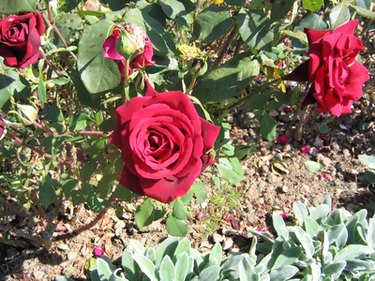
Properly cared for rose bushes produce beautiful blooms all summer long, but as any gardener can attest, roses have sharp, thornlike protrusions that can hurt when you touch them. Roses don't actually have thorns, however.
Prickles and Thorns
Video of the Day
Most types of roses with thorns actually have prickles. Prickles are sharp and spiny and help roses fight off predators. Roses aren't the only plant to have prickles. Raspberry and blackberry bushes also bear similar prickly stems. The prickles are like the hair on your skin. Prickles grow from the epidermis, which is like the skin of a plant.
Video of the Day
You can find thorns in some plants. Thorns are actually shoots, kind of like small branches. Thorns can be found in bougainvillea. Other names of trees with thorns are honey locusts, hawthorn trees and some citrus trees. Older honey locusts may actually have thorns, which are needlelike branches that protrude outward. These can be painful if you get stuck with one, and that's why newer honey locusts have had the thorns bred out of them.
Rose prickles typically mature in about three weeks. Tiny prickles form on the stems of roses, facing upward from the stem. As they mature, however, they grow to about 0.5 to 1 centimeter in length. The prickle, which once faced upward, gradually shifts to face downward, although the degree to which the prickle faces downward varies.
The Purpose of Prickles
These prickles may actually discourage predators from trying to feast on the plant. Scientists also theorize that prickles and the thorns on thorny plants help the plants to better photosynthesize. A larger surface area can help enhance photosynthesis. Scientists have other reasons they think prickles may have evolved. Prickles may help roses direct water to their roots. Prickles may have also encouraged roses and other prickly and thorny plants to sprawl and climb.
Researchers in a 2017 study did in fact find that caterpillars have a harder time reaching the food source of a prickly or thorny plant. When the prickles were shaved off the plants, caterpillars could more easily reach the plants' leaves to munch on them and defoliate the plant.
Unfortunately, the roses of today do have to fight off pests despite the prickles. Deer like to eat roses, and other insects like to munch the stems or leaves. To avoid this problem, buy disease-resistant varieties and keep the area around the rose bush free of debris, weeds, fallen leaves and any part of the plant affected by disease.
Roses Without Prickles
While many rose growers wear thick gloves to guard against the prickles of the plants they love, there are some varieties that are without prickles. Called thornless roses in deference to the common reference to prickles as thorns, these varieties are suggested to plant along walkways and other high-traffic areas. If you're trying to get kids into gardening or if you're planting roses at a senior center, these roses are likely to cause less pain.
You can get thornless or near-thornless varieties that span the palette of rose shades, from white to yellow to deep pink and even mauve. While many are hybrid varieties with little scent, there are even fragrant heritage varieties.
Whether you have rose bushes with or without prickles, you want to prune the stems properly when caring for your roses. Prune in early spring after the leaf buds start to emerge. Wearing thick gloves to protect yourself from the prickles, prune the stems above the leaf buds. In the fall, you don't want to prune your roses. Instead, cut off dead or diseased canes.